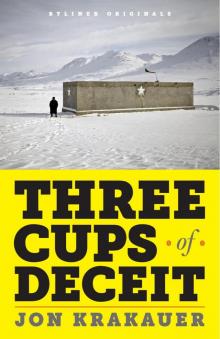- Home
- Jon Krakauer
Eiger Dreams: Ventures Among Men and Mountains Page 4
Eiger Dreams: Ventures Among Men and Mountains Read online
Page 4
"I think I've had some interesting experiences," he says, "because I've `over-trained,' in a sense, for some of these long, easy climbs that I do over and over again. I have these routes wired to such a degree that I don't have to think about the climbing on a conscious level. I become so involved with the flow and the pattern of the climb that I lose touch with who I am and what I am and become part of the rock-I've actually felt at times as though I was weaving in and out of the rock."
"I don't know how much of this I should talk about," Gill says hesitantly in his soft baritone, "because I don't want people to think I've wigged out, but I believe that all the years of mental and physical preparation that I went through in developing both my climbing and mathematical skills-concentrating for long periods of time on a single crystal of rock or getting very deeply into a difficult mathematical problem-made it very easy for me to have certain kinds of mystical experiences.
"In the mid 1970s," Gill elaborates, "a good friend of mine became very interested in Carlos Casteneda's books and kept trying to get me to read them. I've never taken hallucinatory drugs and have no interest in drugs, and I resisted reading these books because I thought they were all about drugs. But my friend finally convinced me that this wasn't the case, and I read them and found them to be fascinating. It may be in his second book-I'm not certain-his central character describes the procedure for initiating himself into the art of dreaming. That so intrigued me that I decided to try it. And I had instant success!
"There are various stages in this dream state or hypnogogic state, this alternate reality. You are entirely conscious, almost more conscious than you are in a regular waking state. Sometimes you can go floating over a city, do that sort of thing, but at other times it's very much like our normal mode of existence where the normal rules of gravitation apply; you're just somewhere else.
"I've found that the easiest time for me to capture this hypnogogic state is during the middle of the night, when I awaken and then slowly drift back to sleep, but I have also entered a similar state while climbing, particularly when soloing those long, easy routes -those times when I feel as though I'm being sewn into the rock. I can come closest then to this second reality, this feeling of lightness. And that, really, is the transcendental poetry of climbing. I consider experiencing that hypnogogic state to be far more important than being able to climb extremely difficult boulder problems that nobody has climbed."
Lately, Gill has become more fascinated than ever with the metaphysical side of bouldering, the inner climbing experience. Once, after drinking a bit of wine, Gill speculated about the possibility that "an excellent mental attitude" may induce a telekinetic ability to levitate, if only slightly. "A few ounces could make a tremendous difference," he muses. "I have seen people go beyond their limits." Hundreds, maybe thousands, of expert climbers have toiled for uncountable hours at the bases of John Gill's boulder problems, trying in vain to get both their feet off the ground. Many of these climbers might ordinarily be inclined to scoff when talk turns to telekinesis and the like, but when Gill talks about levitation, they listen very, very carefully.
VALDEZ, ALASKA, IS A SMALL TOWN WITH TWO BIG CLAIMS TO FAME. The first is that on Good Friday, 1964, this community of four thousand souls, tucked between the foot of the Chugach Mountains and a narrow arm of the sea, was rocked by the most powerful earthquake ever recorded in North America, a catastrophe that killed thirty-three residents. The second, of course, is that Valdez (pronounced val-DEEZ) was also the site of North America's biggest, most environmentally catastrophic oil spill: more than ten million gallons of heavy North Slope crude.
The spilling of all that oil in 1989 is attributable to complacency, corporate greed, a captain's fondness for demon drink, and Murphy's immutable Law; that the oil spilled into Valdez Arm, and not some other body of water, is attributable to a quirk of climate: the trans-Alaska pipeline goes to Valdez, and thus supertankers like the Exxon Valdez go to Valdez, because Valdez is the northernmost ice-free port on the continent.
If the waters of Valdez Arm are free of ice year-round, however, the land that surrounds them is anything but. The fat blue tongues of several glaciers thrust well into the Valdez city limits, and throughout the winter months frigid temperatures and the damp marine air conspire to glaze the downtown streets with a treacherous armor of black ice. But the most impressive ice formations are found on the lower flanks of the mile-high peaks that bristle like shark's teeth, in row after jagged row, just beyond the edge of town.
In summer hundreds of waterfalls pour off these rain-drenched escarpments; come November the falls freeze solid in mid-cascade, their tumbling mists transmogrified by the winter's cold into icicles the size of skyscrapers-towering pillars and bizarre curtains of fragile-looking ice that glow in pale shades of aquamarine and sapphire in the low subarctic light.
About fifteen miles from the center of metropolitan Valdez, the sole highway out of town enters Keystone Canyon: a narrow, eighthundred-foot-deep gash across the hard-rock spine of the Chugach Range, through which the Lowe River rushes to the sea. Although the canyon is only two and a half miles from end to end, in the winter more than fifty frozen waterfalls hang from its vertical and overhanging walls.
Ten years ago, a Valdez ship's agent named Bob Pudwill was driving through Keystone Canyon beneath these forbidding cliffs when, he recalls, "I happened to look up and see a tiny figure standing on a ledge halfway up Bridal Veil Falls," one of the canyon's largest cascades, which, from November until May, turns into a fifty-story-high latticework of delicate blue icicles. The figure on the falls, Pudwill explains, was "stamping his feet and slapping his hands together while paying out a line which ran up to a second tiny figure who appeared to be stuck to the ice, spread-eagled who knows how, let alone why. My only guess was that they must be getting paid."
In fact they were not getting paid, nor, as Pudwill alternately suspected, were they attempting a novel form of suicide; the two people were climbing the waterfall, in a certain historical sense, because it was there: The activity Pudwill witnessed, lunatic though it appeared to be, was nothing less than the latest eminently logical refinement of the venerable sport of mountaineering. Within a year Mr. Pudwill was an ardent waterfall climber himself.
When mountain climbing was invented in the Alps two hundred years ago, it was an admirably simple sport: One found oneself a mountain, the bigger the better, and tried to climb to its top. By and by, however, all the highest summits were reached, and alpinists who wanted to make a mark for themselves were forced to turn to increasingly difficult faces and ridges on peaks that had already been climbed. Eventually the quest for ever greater challenges and virgin vertical ground evolved to the point where, for a good many climbers, reaching a geographically significant summit ceased to be of any interest whatsoever; so long as the climbing was hard enough and steep enough to make adrenaline flow in abundance, it was unimportant whether the object being climbed was a high Himalayan peak or an English rock quarry. Or, indeed, a frozen waterfall in Valdez, Alaska.
A Valdez waterfall known as Wowie Zowie happened to be the objective of John Weiland and Bob Shelton on January 25, 1987. Being that Wowie Zowie plunges from the lip of an overhanging cliff in a single, unbroken, four-hundred-foot drop, and their threeeighths-inch diameter climbing rope was three hundred feet long, the climbers planned to attack the giant icicle in two stages-or "pitches," in the lexicon of ascent-the first of which would end two hundred feet up, at a small hollow in the back of the ice flow.
Shelton started up the first pitch at 9 A.M. In each hand he held an ice axe (a thin six-inch steel pick attached to a sixteen-inch fiberglass handle), and strapped to the soles of his climbing boots were crampons (sets of two-inch steel spikes, twelve per boot, two of which pointed forward from the toe of each foot). By planting the picks of his ice axes with a series of carefully directed swings, and balancing on the toe spikes of his crampons after kicking them half an inch into the ice, Shelton hauled himself up
the sheer face of Wowie Zowie like an overgrown arachnid, a technique known as front-pointing.
To safeguard his ascent as much as possible, every twenty or thirty feet Shelton would pause to twist in an ice screw (a threaded eight-inch aluminum or titanium tube with an eye at one end), clip a carabiner (an aluminum snap-link) through the eye of the screw, and then clip the rope trailing from his waist harness through the carabiner.
By this system, if he were to lose his tenuous attachment to the ice while he was, say, fifteen feet above a screw placement, Shelton could expect to fall about forty feet before his downward flight was arrested by Weiland's belay (belaying being a method of paying out rope in a fashion that permits it to be anchored instantaneously in the event of a fall): Shelton would drop the fifteen feet back down to the screw, another fifteen feet past it, as well as an additional ten feet or so as the rope stretched to absorb the force of the fall. Since falling forty feet with working replicas of the weapon that was used to assassinate Trotsky windmilling about one's person could conceivably do some serious damage, Shelton was trying very hard to heed the adage "the leader must not fall."
A hundred feet off the ground, after two arm-withering hours of battling gravity and the brittle ice of Wowie Zowie, Shelton reached an overlap in the giant icicle, a point where the pillar above overhung his position like a ragged, rotting awning. "I scrunched up under the overhang as tight as I could," Shelton remembers, "and fired in another screw. Then I leaned out past the lip of the roof, got my axes planted on the face of the pillar, yelled down for Johnny to watch my ass, and went for it: I swung out on my arms, cranked off a pull-up, and started front-pointing on up the pillar."
Much to Shelton's dismay, he discovered that the ice of the deadvertical upper pillar was an infirm concoction honeycombed with air pockets, resembling flimsy Styrofoam more than ice. Climbing back down the overhang he'd just surmounted, however, was impossible, so he pushed onward, hoping the condition of the ice would improve as he got higher. Instead, it got worse. As he swung his ice axes over and over with burning arms, trying in vain to chop through the bad ice to find something solid to sink his picks into, he found it harder and harder to keep a grip on the tools. Then, says Shelton, "all of a sudden everything kind of sheared out on me, and I peeled."
"Peel," "catch some air," "take a screamer," "log some flight time"; such are the quaint turns of phrase climbers use to denote the act of falling. In Shelton's case, when he hurtled upside down past the lip of the overhang and the force of the fall plucked his uppermost screw out of the rotten ice like a toothpick from a canape, it began to look like he might actually "crater," a verb reserved for occasions when a climber suffers the misfortune of falling all the way to the ground. Luck, however, was on Shelton's side that Sunday, for the next screw held, and he bounced to a stop on the stretchy nylon rope after falling a mere sixty feet, bruised but otherwise unharmed.
Frozen waterfalls like Wowie Zowie, it should be pointed out, are a fairly new addition to the list of things climbers climb, for the simple reason that until the late 1960s nobody had the means to climb them. Alpinists, to be sure, have been ascending icy faces and gullies since mountaineering's earliest days, but only when the inclines involved were considerably less than vertical. - - - - -- - - -- - - --
By the nineteenth century, climbers shod in hobnailed boots were dispatching ice faces as steep as forty or fifty degrees on Mont Blanc and the neighboring Aiguilles by laboriously hewing long lines of steps and handholds up the slopes with crude, heavy ice axes. In 1908, the upper limit of steepness was pushed a few more degrees toward vertical with the invention, by an English climber named Oscar Eckenstein, of a crampon sporting ten downward-pointing spikes.
By the 1930s, the crampon had sprouted the additional pair of spikes protruding horizontally at the toe, and by the mid-1960s teeth had been notched into the pick-end of the ice axe. With these refinements climbers were able to develop the audacious technique of front-pointing, obviating altogether the need to chop steps, and allowing the leading climbers of the day to claw their way up ice gullies as steep as seventy degrees in the French Alps, the Scottish Highlands, and the Rocky Mountains of North America.
Unfortunately, when climbers tried to push the edge of the envelope further still, they found that their tools were woefully inadequate for the task. On ice steeper than seventy degrees, explains Yvon Chouinard, a compact Californian of French-Canadian descent who was perhaps the premiere ice climber of the 1960s, "even the best ice axes tended to pop out of the ice and hit you in the eye when they were called upon to support much body weight."
Chouinard, a self-taught blacksmith, eked out a living in those days selling state-of-the-art pitons, carabiners, and other climbing paraphernalia of his own innovative design and manufacture. In 1966, after becoming frustrated with the shortcomings of the tools he had used to ascend some of the great ice faces of the Mont Blanc massif, Chouinard resolved to try and come up with something better: an ice axe, specifically, that could be relied upon to stick securely in vertical ice. "On a rainy day that summer," he remembers, "I went out on the Bossons Glacier, above Chamonix, to test every ice axe then available, to try and figure out why they didn't work. "
One thing he immediately noticed was that all the ice axes he tested had been forged with straight picks that were aligned perpendicular to their handles. On a hunch, Chouinard-with the assistance of a climbing partner named Tom Frost, an aeronautical engineer-designed an ice axe with a pick that hooked downward in a gentle curve that matched the arc of the axe as it was swung.
The hunch proved to be a stroke of genius: Armed with a Chouinard-Frost ice axe in each hand, a climber with strong arms and a stout heart could front-point his way up vertical and even overhanging ice. In 1970 the Chouinard-Frost ice axe became available in climbing shops worldwide, launching a string of previously unthinkable ascents of surreal, behemoth icicles from Alaska to Kenya and New Hampshire to Norway, more than a few of which were first climbed by Chouinard himself.
From the late 1950s through the late 1960s, when Chouinard was in his twenties and first developing a reputation as an inventor of extraordinary climbing equipment, he spent much of each year on the road traveling from climbing area to climbing area with a portable coal-fired forge, he says, "just climbing and selling gear I'd make out of the trunk of my car." His income was often meager at best during this period. Frequently his finances were stretched so thin that he and his climbing partners would be forced to subsist on ground squirrels and porcupines, although in relatively flush times, Chouinard recalls, "we'd splurge and buy damaged cans of cat food. We'd get them for a dime apiece, and stock up for the entire summer." Lest anyone get the wrong impression, Chouinard is quick to add that "it was the fancy kind of cat food, the tuna flavored stuff. I mean, I'm not the kind of person who would eat dog food or anything."
Chouinard, now fifty-one years old, is still climbing at a high standard and still making what are widely regarded as the world's finest ice-climbing tools, but these days it's safe to assume that he no longer eats a lot of pet food, even of the fancy feline variety, because the equipment company he started in 1957 from the back of a decrepit Ford has mushroomed into a family of related businesses that take in more than $70 million a year.
The bulk of these revenues come not from sales of ice screws and ice axes and crampons, but from a line of stylish, ingeniously designed outdoor clothing-parkas, rain gear, long underwear, and the like-marketed under the Patagonia label. Chouinard, in fact, says he's never made any money from ice-climbing hardware and never expects to, because ice climbing is such a cold, strange, scary activity that the market for the equipment will always remain extremely limited. Indeed, of the estimated 150,000 Americans who would call themselves serious mountaineers, at most one per cent of them climb frozen waterfalls on a regular basis. "Pretty much the only people who ice-climb," the master ice climber declares matter-of-factly, "are a handful of maladjusted geeks."
Not surprisingly, a disproportionate number of these maladjusted geeks live in or near Valdez, Alaska. Some of the Valdez ice climbers, like Dr. Andrew Embick, one of the town's three physicians, were hard-core climbing fanatics from the lower forty-eight who emigrated to the area, at least in part, specifically to take advantage of its icy munificence; others were ordinary nonclimbing residents who had no idea when they arrived in the region that a bizarre sport like waterfall climbing even existed, let alone that they would one day take it up themselves.
Ice climbing can be a seductive pastime. When John Weiland- who introduced waterfall climbing to Valdez in 1975-speaks about his early climbing experiences, you have to remind yourself that he is talking about a sport, not a form of substance abuse. "My father was an obsessed climber," the thoughtful forty-one-year-old carpenter reports, "so I was exposed to it at an early age, and got completely hooked on the sport, too. Climbing was like a drug to me, it was everything."
In 1976, not long after he and visiting Coloradan Jeff Lowe completed the three-day first ascent of Keystone Green Steps, at 650 feet the biggest waterfall in Valdez, Weiland began to resent the way his magnificent obsession was monopolizing his life. He forced himself to quit climbing, cold turkey, and managed to remain on the wagon for nearly six full years. In 1981, however, in a weak moment he dusted off his ice tools and did a little climbing, just to prove to himself that he could take it or leave it, and has been back fooling around on frozen waterfalls ever since. Weiland soberly insists, however, that he "got back into it real slowly, and I've been careful not to go crazy with it this time around. I feel like I'm in control now."

 Into the Wild
Into the Wild Into Thin Air
Into Thin Air Under the Banner of Heaven: A Story of Violent Faith
Under the Banner of Heaven: A Story of Violent Faith Eiger Dreams: Ventures Among Men and Mountains
Eiger Dreams: Ventures Among Men and Mountains Three Cups of Deceit: How Greg Mortenson, Humanitarian Hero, Lost His Way
Three Cups of Deceit: How Greg Mortenson, Humanitarian Hero, Lost His Way Under the Banner of Heaven
Under the Banner of Heaven Missoula
Missoula Classic Krakauer
Classic Krakauer